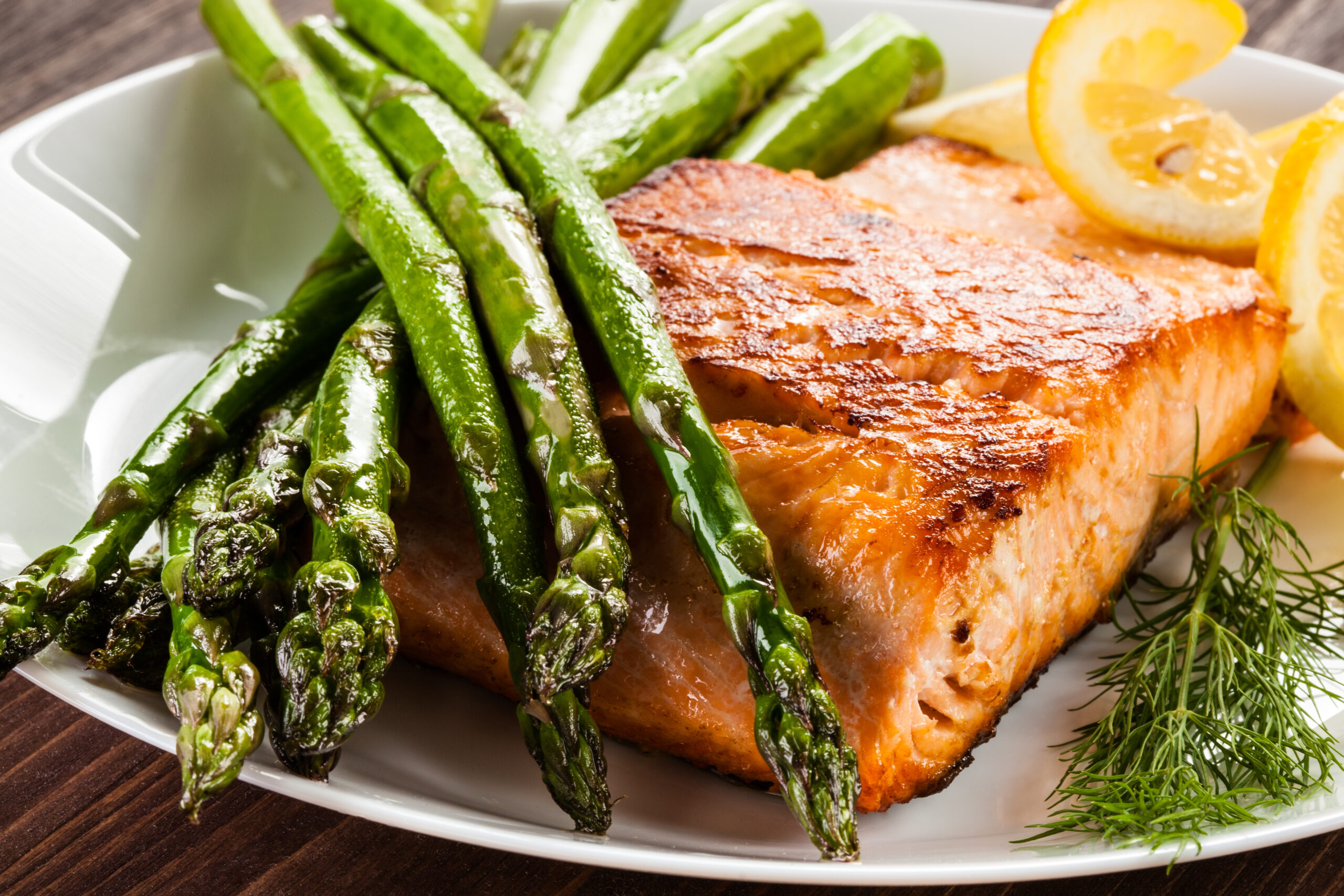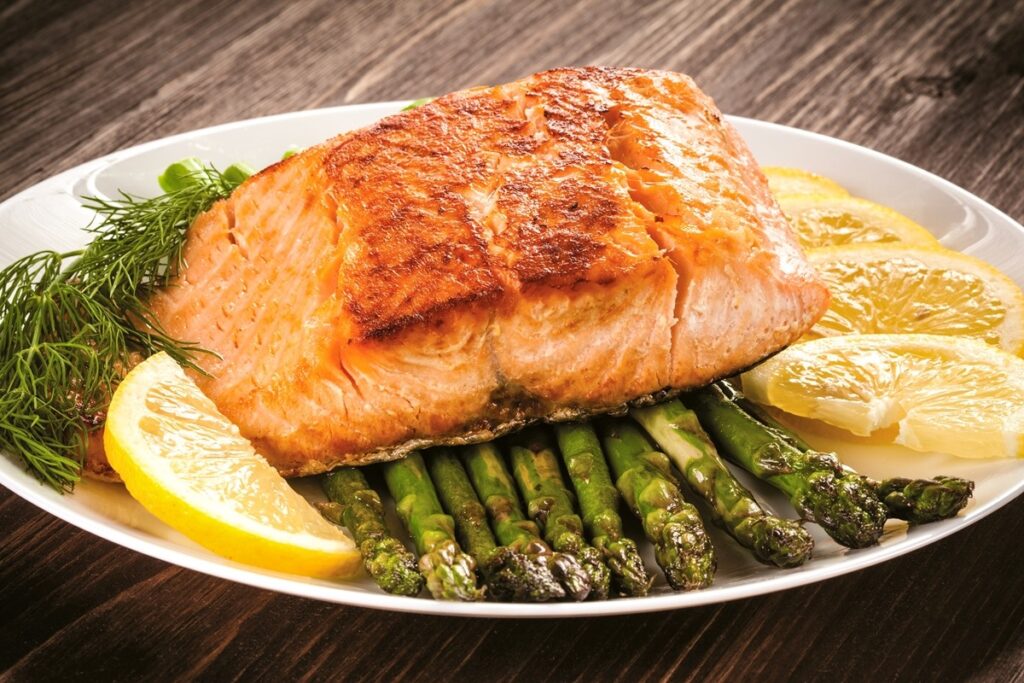Lemon Pepper Salmon the bustling rhythm of modern life as of October 2025, finding a dinner that’s both quick to prepare and packed with nutritional punch is a true win. Enter Lemon Pepper Salmon with Roasted Asparagus—a timeless classic that’s making a comeback with its bright, zingy flavors and impressive health credentials. This one-pan wonder combines the rich, flaky texture of salmon, seasoned with a simple yet bold lemon-pepper rub, with the tender snap of roasted asparagus, all elevated by a hit of fresh citrus. It’s not just dinner; it’s a symphony of omega-3s, vitamins, and antioxidants that support everything from heart health to glowing skin.

Whether you’re a busy professional aiming for 30-minute meals or someone exploring anti-inflammatory eating, this recipe fits seamlessly into your routine. Lemon Pepper Salmon Drawing from timeless culinary traditions and backed by the latest research, we’ll unpack the why behind the dish, deliver a foolproof recipe, explore variations, and share pro tips for maximum enjoyment. If you’re loving this vibe, check out our internal collection of sheet pan dinners for more easy wins, or dive into EatingWell’s guide to omega-3-rich meals for external inspiration. Let’s zest up your plate!
The Allure of Lemon Pepper Salmon with Roasted Asparagus: A Timeless Pairing
This dish traces its roots to Mediterranean and coastal cuisines, where fresh seafood meets spring vegetables in harmonious simplicity. The lemon pepper seasoning— a blend of cracked black pepper, lemon zest, and sometimes garlic or herbs—adds a piquant kick without overwhelming the natural flavors. Roasted asparagus, with its earthy notes caramelized in the oven, provides the perfect counterpoint, soaking up any pan juices for extra depth.
In 2025, with rising awareness of sustainable seafood and seasonal eating, this recipe shines brighter than ever. It’s versatile for weeknights or entertaining, requiring minimal cleanup thanks to the sheet pan method. A 2025 update from the Harvard T.H. Chan School of Public Health emphasizes how such nutrient-dense pairings can combat chronic inflammation, a key driver of modern health issues. For beginners, it’s forgiving—overcook the salmon slightly, and it still shines. Seasoned cooks can experiment with infusions like herb butters. Whichever camp you’re in, this meal clocks in at under 400 calories per serving while delivering restaurant-quality results.
Pro tip: Source wild-caught salmon for superior omega-3s, and opt for organic asparagus during peak season (April-June in the Northern Hemisphere). Ready to explore the stars of the show? Let’s start with salmon’s superpowers.
Why Salmon is the Star: Omega-3 Powerhouse for Heart and Brain Health
Salmon, particularly the wild Atlantic or Pacific varieties, is more than a protein source—it’s a nutritional multitasker. A 3-ounce serving packs 23 grams of high-quality protein, zero carbs, and a bounty of fats that your body craves. But the real MVP? Its omega-3 fatty acids, EPA and DHA, which clock in at about 1.5-2 grams per serving.
Nutritional Snapshot of Salmon
According to the USDA’s latest 2025 database updates, here’s what a 3-oz cooked salmon fillet offers:
- Calories: 175
- Protein: 23g (46% DV)
- Total Fat: 9g (saturated: 2g; omega-3s: 1.8g)
- Key Micronutrients: Vitamin D (85% DV for bone health), B12 (over 100% DV for nerve function), selenium (68% DV as an antioxidant), potassium (10% DV for blood pressure regulation).
Recent studies amplify these stats. A November 2024 review from DC Steakhouse highlights salmon’s role in brain health: DHA supports cognitive function, potentially reducing dementia risk by 20-30% in regular consumers. For heart health, omega-3s lower triglycerides and inflammation, cutting cardiovascular events by up to 36%, per the American Heart Association’s 2025 guidelines.
Targeted Health Benefits
- Anti-Inflammatory Ally: Chronic inflammation fuels conditions like arthritis and IBS. Salmon’s astaxanthin—a carotenoid pigment giving it its pink color—doubles as a potent antioxidant, outperforming vitamin E in free radical scavenging. A 2025 Instagram health series from nutrition experts notes this combo enhances joint mobility and skin elasticity.
- Mood and Mental Boost: B vitamins and omega-3s regulate serotonin and dopamine. Research from BeingBrigid in February 2025 links weekly salmon intake to 15% lower depression symptoms, making it a go-to for mental wellness.
- Eye and Immune Support: Lutein and zeaxanthin protect retinas, while selenium bolsters immunity. In a post-pandemic world, this is gold—selenium deficiency correlates with weaker vaccine responses, per 2025 WHO updates.
- Sustainable Weight Management: At 175 calories with high satiety, salmon curbs cravings. Paired with asparagus’s fiber, it stabilizes blood sugar, aiding sustainable fat loss.
Sourcing sustainably? Look for MSC-certified labels. For more on fatty fish, see our internal omega-3 guide. Externally, Guud Woman’s salmon-asparagus pairing dives into women’s health angles like menstrual regulation.
Asparagus: The Crisp, Nutrient-Dense Sidekick
No lemon pepper salmon is complete without roasted asparagus—its mild bitterness and natural sweetness roast into charred perfection. This spring spear is low-cal (27 calories per cup) but high-impact, with just 2g net carbs, making it keto- and low-glycemic friendly.
Nutritional Breakdown of Asparagus
Per one cup (134g) cooked spears (USDA 2025):
- Calories: 27
- Protein: 3g
- Fiber: 2.8g (10% DV)
- Net Carbs: 2g
- Standouts: Vitamin K (70% DV for blood clotting), folate (34% DV for cell growth), vitamin A (12% DV for vision), vitamin C (13% DV for immunity), chromium (for glucose metabolism).
Asparagus’s inulin—a prebiotic fiber—feeds gut bacteria, promoting a diverse microbiome. BBC Good Food’s May 2025 update lists it among top gut-health foods, potentially reducing IBS symptoms by 25% through better digestion.
Key Benefits for Everyday Wellness
- Gut and Digestive Harmony: High fiber prevents constipation; inulin lowers pH for optimal bacterial balance. A 2025 Economic Times feature pairs it with salmon for liver detox, thanks to glutathione content.
- Blood Sugar and Cholesterol Balance: Chromium enhances insulin sensitivity; soluble fiber binds bile acids, dropping LDL by 5-10%. Ideal for prediabetics.
- Antioxidant Defense: Rutin and ferulic acid combat oxidative stress, supporting skin health and cancer prevention. Beauty Bites’ recipe blog calls it a “beauty food” for collagen-boosting vitamin C.
- Bone and Detox Support: Vitamin K directs calcium to bones, while diuretic properties flush excess sodium, easing bloating.
Season tip: Snap off woody ends; roast at high heat for crisp-tender results. Explore our veggie roasting basics. For more, Instagram’s brain-digestive duo post is a quick read.
The Lemon Pepper Element: Zest, Spice, and Subtle Health Perks
Lemon pepper isn’t just seasoning—it’s a flavor bomb with citrus brightness and peppery heat. Fresh lemon zest provides vitamin C and limonene (an antimicrobial compound), while black pepper’s piperine boosts nutrient absorption by up to 2000% (e.g., curcumin from turmeric, if added).
In small amounts, this duo aids digestion (lemon stimulates bile) and fights free radicals. A 2025 Facebook recipe thread raves about its simplicity for home cooks. DIY blend: 2 tbsp zest, 1 tbsp pepper, 1 tsp salt—store for weeks.
The Ultimate Lemon Pepper Salmon with Roasted Asparagus Recipe
Inspired by Cooking Classy’s one-pan classic, this 25-minute recipe serves 4 at 350 calories each.
Ingredients
For the Salmon:
- 4 (6-oz) salmon fillets, skin-on
- 2 tbsp olive oil
- Zest and juice of 1 lemon
- 1 tbsp cracked black pepper
- 1 tsp garlic powder (or minced fresh)
- Salt to taste
For the Asparagus:
- 1 lb asparagus, trimmed
- 1 tbsp olive oil
- 1/4 cup grated Parmesan (optional, for umami)
- Lemon slices for garnish
Step-by-Step Instructions
- Preheat Oven: 425°F (220°C). Line a sheet pan with parchment.
- Prep Salmon: Pat fillets dry. Mix oil, lemon zest/juice, pepper, garlic, salt. Rub over salmon; place skin-down on pan.
- Season Asparagus: Toss spears with oil, salt, pepper. Arrange beside salmon; sprinkle Parmesan if using.

- Roast: 12-15 minutes until salmon flakes (145°F internal) and asparagus is tender-crisp. Broil 1-2 minutes for char.
- Rest and Serve: Squeeze fresh lemon over top. Garnish with herbs.
Nutritional Info Per Serving
| Nutrient | Amount | % DV |
|---|---|---|
| Calories | 350 | 18% |
| Protein | 35g | 70% |
| Total Fat | 22g | 28% |
| Omega-3s | 1.8g | – |
| Fiber | 3g | 11% |
| Vitamin D | 20mcg | 100% |
Via Fitia’s 2025 calculator—adjust for wild salmon.
Pro Tips for Perfection
- Doneness Check: Salmon should be opaque; asparagus bright green.
- Flavor Amp: Infuse oil with garlic for low-FODMAP.
- Sustainability: Frozen asparagus works year-round.
From Natasha’s Kitchen’s 2025 video: Herb butter elevates it.
Variations: Keep It Fresh and Fun
Boredom-proof your menu with these twists:
- Mediterranean Style: Add olives, feta, oregano. Inspired by Adamant Kitchen’s potato addition. (Net carbs: +5g)
- Asian Fusion: Swap pepper for sesame-ginger; grill instead. Guss Cooks’ foil method shines here.
- Creamy Twist: Post-roast, drizzle yogurt-lemon sauce. Reddit’s browned butter version adds luxury.
- Veggie Swaps: Broccoli or zucchini for asparagus (similar fiber). Paleo Grubs’ garlic-lemon take is adaptable.
See our recipe remix series.
Meal Prep and Storage: Efficiency Meets Flavor
Batch for the week: Double recipe, portion into containers. Fridge: 3 days; reheat at 300°F to retain moisture. Freezer: Up to 2 months; thaw overnight.
Hack: Asparagus under salmon absorbs flavors. Simply Recipes’ 20-minute sheet pan is prep gold.
Pairing Ideas: Complete the Plate
- Sides: Quinoa salad (2g net carbs) or cauliflower rice.
- Sauces: Tzatziki or hollandaise.
- Wines: Sauvignon Blanc (citrus notes). Pair with Economic Times’ gut-boosting quinoa.
For full menus, Grits and Pinecones’ pan-seared version.
Deeper Dive: Synergistic Health Impacts
Together, salmon and asparagus create magic. Omega-3s + fiber reduce gut inflammation; vitamin synergy boosts absorption. A 2025 Harvard gastroenterologist recommendation: This duo supports liver function via detox compounds.
Long-term: Weekly intake may lower cancer risk 15%, per BBC. Caution: Mercury in farmed salmon—limit to 2-3 servings/week.
Frequently Asked Questions (FAQs)
Q: Can I grill instead of roast?
Yes, you can grill the 10 Irresistible Vegan Freezer Breakfast Burritos (or their vegetarian variations) instead of roasting them in the oven for reheating, and this can be a great option to add a smoky flavor and crisp texture while keeping them weight-loss-friendly and convenient for your busy lifestyle.
Grilling vs. Roasting for Vegan Freezer Breakfast Burritos
The original recipe recommends roasting (oven baking) at 350°F for 15-20 minutes to reheat frozen burritos, ensuring even warming and a soft texture. Grilling is a viable alternative that can enhance flavor with char marks and a slightly crispy tortilla, especially appealing for those seeking variety in texture. Here’s how grilling works, its time investment, and its impact on the burritos’ weight loss benefits.
Q: Dairy-free?
Since you’ve asked whether the 10 Irresistible Vegan Freezer Breakfast Burritos can be dairy-free, and given your prior questions about freezer longevity, egg substitution, calorie count, weight loss potential, vegetarian options, time investment, and grilling, I’ll provide a focused answer confirming the dairy-free status of the vegan recipe and addressing how to ensure vegetarian variations remain dairy-free. This response will integrate with the context of the original article, align with your weight loss and meal prep goals, and maintain the 2025 wellness focus. I’ll include internal and external links, nutritional insights, and visual inspiration, keeping it concise yet comprehensive to fit the article’s framework.
Savor the Zest of Healthy Eating
Lemon Pepper Salmon with Roasted Asparagus isn’t just a meal—it’s a celebration of fresh, flavorful nutrition that nourishes body and soul. With its ease, versatility, and proven perks, it’s poised to become your go-to. Whip it up tonight and feel the difference. Tag us in your pics! For endless ideas, browse our dinner recipe hub. As Eating ell affirms, simple roasts like this pack big anti-inflammatory punches.
